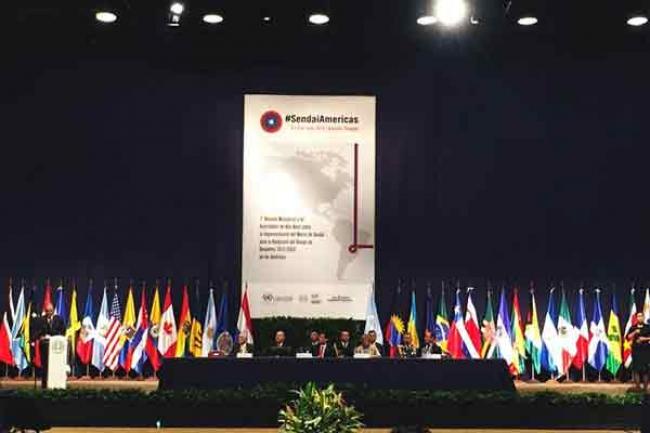Just Earth News 09 Jun 2016, 08:11 am Print

UN Radio/Carla GarcÃa
Addressing the First Meeting of Ministers and High-Level Authorities on the Implementation of the Sendai Framework for Disaster Risk Reduction 2015-2030 in the Americas, Robert Glasser called for greater efforts to reduce financial damage and to lessen social vulnerabilities.
“The really critical issue that needs the region’s attention, and indeed global attention, is reducing economic losses and preventing creation of new disaster risk by risk-proofing investments,” said Glasser, who is the Special-Representative of the UN Secretary-General for Disaster Risk Reduction.
The international community also needs “to demonstrate an inclusive, people-centred approach which engages the whole of society and all sectors,” noted Glasser, who is also the head of the UN Office for Disaster Risk Reduction (UNISDR).
Speaking in Asunción, the capital of Paraguay, he addressed ministers and delegates from 35 countries at the two-day conference. Members of civil society and the private sector from the region are also participating.
“We are united here on Wedesday by a common purpose, which is to make the world a safer and more resilient place for future generations,” the UN disaster risk reduction official said. Some 93 major disasters were recorded in the Americas in 2015, second only to Asia as the most disaster-prone region in the world.
The disaster include a 7.8 magnitude earthquake in north-western Ecuador in April which killed more than 650 people and left 73,000 homeless and flooding in the Paraguayan capital Asunción. United Nations agencies, funds and programmes have been working with partners in support of people still in need of urgent aid.
In addition, hurricanes, volcanic activity and flooding and drought brought on by the El Niño weather phenomenon have all taken their toll on human life in recent years in various parts of the Americas.
The meeting was formally opened by the President of Paraguay, Horacio Cartes Jara and represents the region’s first opportunity to discuss how to implement the Sendai Framework . Adopted in the Japanese city of the same name in March 2015, the Framework is an internationally agreed strategy to reduce the number of people who die in or who are otherwise affected by disasters. It focuses both on natural and man-made disasters and aims to substantially reduce losses in lives, livelihoods and damage to the environment.
The Sendai Framework is also considered a key driver of poverty eradication and an important part of the 2030 Agenda for Sustainable Development which was agreed to by world leaders in September of last year.
The South American country’s national emergencies minister, Joaquin Roa Burgos, gave a keynote address acknowledging the importance of the Sendai Framework.
“It has presented us with a new emphasis in terms of disaster management, which includes preventing new risks and increasing the resilience of our people.”
The main objective of the two-day meeting in Asunción is the development of guidelines for a regional action plan that will encourage countries and communities to reduce the risk of disasters occurring and when they do to make sure people are prepared for the aftermath.
The plan which will be known as the Declaration of Asunción will be developed between June and the holding of the Americas Regional Platform for Disaster Risk Reduction in March 2017 where it is expected to be approved.
- USD 5,000 fine for illegal entry: US unveils toughest immigration penalty yet
- Bangladesh: Former PM Khaleda Zia’s emergency medical evacuation to London delayed. Know the reason
- Mystery killing in Gaza: Key anti-Hamas leader Yasser Abu Shabab dead
- Washington DC shooting fallout: USCIS indefinitely halts Afghan immigration pending security and vetting review
- Trump accepts Xi’s invitation for Beijing visit during telephone interaction: Talks cover trade, Ukraine, and Fentanyl



-1763561110.jpg)


